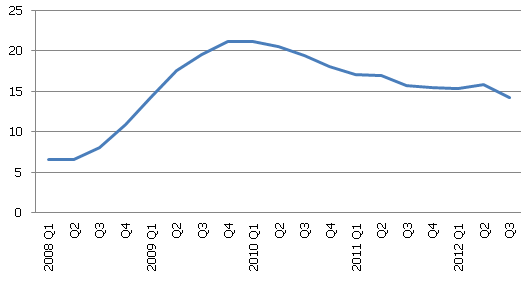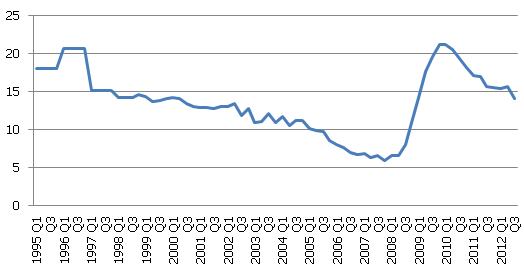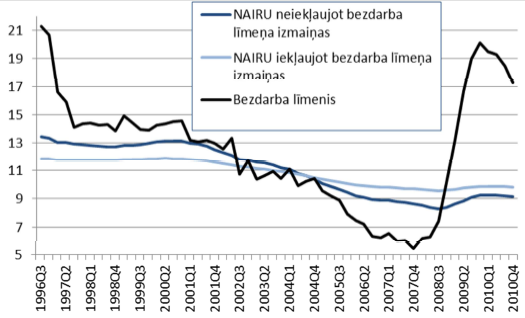The Latvian Unemployment is Cyclical: a Comment
Latvia's economic developments, particularly dynamics of unemployment, continue to inspire economists from all over the world. FREE Policy Brief Series recently posted a paper written by Latvian economists Alf Vanags and Anna Zasova in collaboration with their Russian counterparts Konstantin Sonin and Daria Anosova titled "The Latvian Unemployment is Cyclical". The paper argues that the increase of unemployment in 2009-2010 can be almost fully attributed to cyclical factors. The conclusion is that Latvia's high unemployment is a cyclical problem, thus, broad demand supporting measures can be effective.
Discussion
The authors did a great job to apply various methods to assess the sources of the changes of unemployment rate. As a labour economist, I feel curious every time when a paper on topic is published, particularly, written by my colleagues. However, it seems to me that some places in the text need clarification and proper discussion. I believe that some of my comments may be helpful for further research efforts on the topic.
Changes vs. Level
The empirical part of the paper focuses on unemployment changes while the title and conclusions are regarding unemployment level. If unemployment changes are mostly cyclical, it means that structural component during the recession was broadly flat. And if structural component is constantly high, it constitutes a lion share of unemployment level whatever fluctuations of cyclical component are. However, the paper does not provide any estimation of the structural unemployment level, intrinsically assuming that it is rather small.
Research period
Research period is rather short due to the data availability problem. The first two sections show results for 2008 Q1 – 2011 Q4 and the latter section - for 2005 Q1 – 2012 Q2. Still, unemployment rate data are available at least as from the mid 1990-ties, but the paper shows it only as from 2008.
When I look at unemployment rate from 2008, I feel like unemployment always was low and suddenly rose in 2009. In this case, if unemployment rise is cyclical, also unemployment level is primarily cyclical (and paper's title is ok). And sticky unemployment at around 15% (as from 2011 Q3; see figure 1) looks like a policy failure (austerity impact?) making paper's suggestion to combat cyclical component sounding reasonable.
Figure 1. Unemployment Rate (Age Group 15-74), Seasonally Adjusted (%)

Source: Eurostat
However, if one looks at a longer time horizon, it seems like Latvian unemployment problem is at least 18 years old, taking roots from the transition shock. Thus, even if in 2009 unemployment rise was cyclical, lion's share of unemployment level is indeed structural. In this case, paper's suggestion to combat cyclical component alone (and forget about persistently high structural component) looks rather less convincing.
Figure 2. Unemployment Rate (Age Group 15-74), Seasonally Adjusted (%)

Source: Eurostat (as from 1998); Central Statistical Bureau of Latvia (National Accounts Yearbooks) for 1995-1997
How big is structural unemployment component?
The paper does not provide any evidence on level of either structural component or natural rate of unemployment (despite some of the authors were engaged in estimation / discussion of this topic earlier). So let's fill the gap.
According to the European Commission AMECO database (2013), natural rate of unemployment in Latvia behaved similar to the letter "U". It was 15% in 1997, then fell to 11% and came back almost to 15%. Both in 1997 and 2012 output gap was almost closed.
Figure 3. Unemployment: natural rate and headline data

Source: Eurostat (as from 1998); Central Statistical Bureau of Latvia (National Accounts Yearbooks) for 1997; EC AMECO database
However, the paper intrinsically follows Zasova (PhD Thesis; 2012) where she disputed EC results and argued that EC may overestimate the elasticity of unit labour costs in respect to the unemployment gap, thus, EC natural rate of unemployment may be too close to the headline data. Nevertheless, from the analytical perspective, her estimation is not self-evident either. Why unemployment consistently exceeded the NAIRU in 1996-2000? Was positive output gap in 2007 really small, followed by a huge negative output gap in 2009?...
Figure 4. Unemployment rate (Age Group 15-74; black line), Seasonally Adjusted (%) and NAIRU (blue lines)

Source: Zasova (2012)
How reliable NAIRU estimates are?
Nobody knows precisely how big the structural component / natural rate of unemployment in Latvia is. A particular quantitative estimation in a small open post-transition country is challenged by the data availability (short time series), data quality (methodological breaks) and model consistency (large fluctuations in participation rate, emigration etc.) problems. Below I list some of these problems.
- Labour Force Survey data experienced a major methodological adjustment when 2011 Population Census data were revealed. Historical unemployment data were corrected upwards, particularly at the end of period (e.g., +0.6 pp. in 2005; +1.3 pp. in 2009; +1.1 pp. in 2010). This correction is likely to increase natural rate of unemployment at the end of period, but was not elaborated yet in Zasova (2012).
- How meaningful is NAIRU quantitative estimation in situation of unstable labour force? NAIRU is rigid by construction, thus, although long run estimation (like 10-year average) is reliable, it is unable to reveal sudden structural changes in the labour market, in particular:
- Government's attempt to change a pension system halved the number of pensioners in the labour force as from 2009 Q3. For instance, the share of persons older than 60 years in the labour force (cohort with very low - virtually zero unemployment, because almost all people without a job are economically inactive) was 8.4% in 2009 Q2 and 4.9% in 2009 Q3. Did it increased natural rate of unemployment? Definitely. But not its econometric estimation.
- Almost 10% of the Latvian labour force emigrated as from 2008 (precise number is not published yet). NAIRU intrinsically assumes labour is homogenous, so whatever is migration, it does not change the NAIRU. But this assumption is far from reality.
- Participation rate in 2012 is significantly higher than during the pre-boom period, partly because of the demographic factors (share of cohorts with the highest participation rate (age 25-54) increased), and partly because previously discouraged workers entered the labour force. Again, clearly it affects NAIRU (yesterday's discouraged may be more likely to be unemployed today), but disregarded by econometric methods.
To sum up
Evidence that unemployment changes are mostly cyclical does not mean that nowadays Latvia suffers from cyclical unemployment. For instance, cyclical component may has been -5 pp. in 2007 and +5 pp. in 2009. Unless we return to -5 pp. again, statistical methods to decompose unemployment changes will show that "accumulated increase of the cyclical component" is positive. But return to -5 pp. ("boom number two") is not a feasible policy purpose, thus, we may conclude that Latvia will suffer from cyclical unemployment forever.
NAIRU estimates do not provide a clear picture whether cyclical component of unemployment today is already at zero or it is still positive. But it is clear that cyclical component is decreasing fast (in 2012 Q3 Latvia took the first place in the EU subject to the job creation rate) while NAIRU is broadly flat both according to the EC and Zasova. Therefore, paper's suggestion to take steps to combat cyclical component (forgetting about persistently high structural component) is not based on robust empirical footing, I'm afraid.
All existing estimates of the natural rate of unemployment (either it is 14% or 10% or somewhere in between) do provide a clear picture that:
- Today structural unemployment component in Latvia constitutes a lion's share of total unemployment (unemployment rate was 14% at Q3 2012);
- Structural unemployment component in Latvia is very high compared to the other countries (Germany, Austria, Denmark, Iceland, USA etc.).
Therefore, I would like to see more policy actions on problems we have identified for sure (e.g., structural component), compared to the ambiguous findings on which each researcher may come with its own result (cyclical component). Latvian unemployment problem is mostly structural and is at least 18 years old. Without effective structural policy actions (targeted on particular population groups, regions etc.) unemployment rate could not be sustainably decreased to the level of advanced countries (5% and less).
Textual error
«… …»


